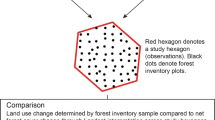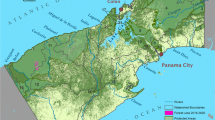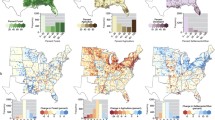Abstract
Federal lands in the United States have been identified as important areas where forests could be managed to enhance carbon storage and help mitigate climate change. However, there has been little work examining the context for decision making for carbon in a multiple-use public land environment, and how science can support decision making. This case study of the San Juan National Forest and the Bureau of Land Management Tres Rios Field Office in southwestern Colorado examines whether land managers in these offices have adequate tools, information, and management flexibility to practice effective carbon stewardship. To understand how carbon was distributed on the management landscape we added a newly developed carbon map for the SJNF–TRFO area based on Landsat TM texture information (Kelsey and Neff in Remote Sens 6:6407–6422. doi:10.3390/rs6076407, 2014). We estimate that only about 22 % of the aboveground carbon in the SJNF–TRFO is in areas designated for active management, whereas about 38 % is in areas with limited management opportunities, and 29 % is in areas where natural processes should dominate. To project the effects of forest management actions on carbon storage, staff of the SJNF are expected to use the Forest Vegetation Simulator (FVS) and extensions. While identifying FVS as the best tool generally available for this purpose, the users and developers we interviewed highlighted the limitations of applying an empirically based model over long time horizons. Future research to improve information on carbon storage should focus on locations and types of vegetation where carbon management is feasible and aligns with other management priorities.








Similar content being viewed by others
Notes
References
Blackard J, Finco M, Helmer E, Holden G, Hoppus M, Jacobs D, Lister A, Moisen G, Nelson M, Reimann R (2008) Mapping US forest biomass using nationwide forest inventory data and moderate resolution information. Remote Sens Environ 112(4):1658–1677. doi:10.1016/j.rse.2007.08.021
Bradley BA, Houghton RA, Mustard JF, Hamburg SP (2006) Invasive grass reduces aboveground carbon stocks and shrublands of the western US. Glob Change Biol 12:1815–1822. doi:10.111/j.365-2486.2006.-1232.x
Branson FA, Miller RF, McQueen IS (1976) Moisture relationship in twelve northern deser shrub communities near Grand Junction, Colorado. Ecology 57(6):1104–1124
Cash DW, Moser SC (2000) Linking global and local scales: designing dynamic assessment and management processes. Glob Environ Change 10:109–120
Chave J, Condit R, Aguilar S, Hernandez A, Lao S, Perez R (2004) Error propagation and scaling for tropical forest biomass estimates. Philos Trans R Soc Lond B Biol Sci 359(1443):409–420. doi:10.1098/rstb.2003.1425
Crookston NL, Dixon GE (2005) The forest vegetation simulator: a review of its structure, content, and applications. Comput Electron Agric 49(1):60–80. doi:10.1016/j.compag.2005.02.003
Crookston NL, Rehfeldt GE, Dixon GE, Weiskittel AR (2010) Addressing climate change in the forest vegetation simulator to assess impacts on landscape forest dynamics. For Ecol Manag 260(7):1198–1211
Cutler MEJ, Boyd DS, Foody GM, Vetrivel A (2012) Estimating tropical forest biomass with a combination of SAR image texture and Landsat TM data: an assessment of predictions between regions. ISPRS J Photogramm Remote Sens 70:66–77. doi:10.1016/j.isprsjprs.2012.03.011
Dilling L, Failey E (2013) Managing carbon in a multiple use world: the implications of land-use decision context for carbon management. Glob Environ Change 23:291–300. doi:10.1016/j.gloenvcha.2012.10.012
Dilling L, Lemos MC (2011) Creating usable science: opportunities and constraints for climate knowledge use and their implications for science policy. Glob Environ Change 21:680–689. doi:10.1016/j.gloenvcha.2010.11.006
Dilling L, Birdsey R, Pan Y (2013) Opportunities and challenges for carbon management on US public lands. In: Brown D, Robinson D, French N, Reed B (eds) Land use and the carbon cycle. Cambridge University Press, Cambridge, pp 455–476
Dixon GE (2002) Essential FVS: a user’s guide to the forest vegetation simulator. US Department of Agriculture, Forest Service, Forest Management Service Center, Fort Collins (revised 2011)
DOI/USFS (2013) Final San Juan National Forest and Proposed Tres Rios Field Office Land and Resource Management Plan. US Department of Interior, Bureau of Land Management, Colorado Southwest District, Tres Rios Field Office, and US Department of Agriculture, US Forest Service Region 2, San Juan National Forest, September
Dubayah RO, Drake JB (2000) Lidar remote sensing for forestry. J For 98(6):44–46
Dwire KA, Kauffman JB, Brookshire ENJ, Bahan JE (2004) Plant biomass and species composition along an environmental gradient in montane riparian meadows. Oecologia 139(2):309–317. doi:10.1007/s00442-004-1498-2
Edminster CB, Mowrer HT, Mathiasen RL, Schuler TM, Olsen WK, Hawksworth FG (1991) GENGYM: a variable density stand table projection system calibrated for mixed conifer and ponderosa pine stands in the southwest. In: Research Paper RM-297. USDA Forest Service, Rocky Mountain Forest and Range Experiment Station, Fort Collins, p 32
Ellenwood MS, Dilling L, Milford JB (2012) Managing United States public lands in response to climate change: a view from the ground up. Environ Manag 49:954–967. doi:10.1007/s00267-012-9829-2
Failey E, Dilling L (2010) Carbon stewardship: land management decisions and the potential for carbon sequestration in Colorado, USA. Environ Res Lett 5(2):1–8
Fernandez DP, Neff JC, Huang C, Asner GP, Barger NB (2013) Twentieth century carbon stock changes related to Pinon–Juniper expansion into a black sagebrush community. Carbon Balance Manag. doi:10.1186/1750-0680-8-8
Fowler HJ, Blenkinsop S, Tebaldi C (2007) Linking climate change modelling to impacts studies: recent advances in downscaling techniques for hydrological modelling. Int J Climatol 27(12):1547–1578. doi:10.1002/joc.1556
Galik CS, Mobley ML, de Richter D (2009) A virtual ‘field test’ of forest management carbon offset protocols: the influence of accounting. Mitig Adapt Strateg Glob Change 14(7):677–690. doi:10.1007/s11027-009-9190-9
Gallardo A, Schlesinger WH (1992) Carbon and nitrogen limitations of soil microbial biomass in desertecosystems. Biogeochemistry 18:1–17
Goetz SJ, Baccini A, Laporte NT, Johns T, Walker W, Kellndorfer J et al (2009) Mapping and monitoring carbon stocks with satellite observations: a comparison of methods. Carbon Balance Manag 4(1):2. doi:10.1186/1750-0680-4-2
Havstad KM, Schlesinger WH (1996) Reflections on a century of rangeland research in the Jornada basin of New Mexico. In: Barrow JR, McArthur ED, Sosebee RE, Tausch RJ (eds) Proceedings: symposium on shrubland ecosystem dynamics in a changing environment. US Department of Agriculture, Forest Service, Intermountain Research Station, Ogden, pp 10–15
Healey SP, Urbanski SP, Patterson PL, Garrard C (2014) A framework for simulating map error in ecosystem models. Remote Sens Environ 150:207–217. doi:10.1016/j.rse.2014.04.028
Heath LS, Smith JE, Woodall CW, Azuma DL, Waddell KL (2011) Carbon stocks on forestland of the United States, with emphasis on USDA Forest Service ownership. Ecosphere. doi:10.1890/ES10-00126.1
Hoover CM, Rebain SA (2011) Forest carbon estimation using the Forest Vegetation simulator: seven things you need to know. General Technical Report NRS-77. US Department of Agriculture, Forest Service, Northern Research Station, Newtown Square
Huete AR, van Leeuwen WJD (1997) The use of vegetation indices in forested regions: issues of linearity and saturation. In: IGARSS’97. 1997 IEEE International Geoscience and Remote Sensing Symposium Proceedings. Remote Sensing-A Scientific Vision for Sustainable Development, vol. 4, pp. 1966–1968. IEEE. doi:10.1109/IGARSS.1997.609169
Hurteau MD, North M (2010) Carbon recovery rates following different wildfire risk mitigation treatments. For Ecol Manag 260:930–937. doi:10.1016/j.foreco.2010.06.015
Hurteau MD, Koch GW, Hungate BA (2008) Carbon protection and fire risk reduction: toward a full accounting of forest carbon offsets. Front Ecol Environ 6:493–498. doi:10.1890/070187
Kasischke ES, Melack JM, Dobson CM (1997) The use of imaging radars for ecological applications—a review. Remote Sens Environ 59(2):141–156. http://www.sciencedirect.com/science/article/pii/S0034425796001484
Kellndorfer J, Walker W, LaPoint E, Bishop J, Cormier T, Fiske G, Hoppus M, Kirsh K, Westfall J (2000) NACP aboveground biomass and carbon baseline data. Data Set. Available at: http://daac.ornl.gov/NACP/guides/NBCD_2000.html. Accessed 4 June 2016
Kelsey KC, Neff JC (2014) Estimates of aboveground biomass from texture analysis of Landsat imagery. Remote Sens 6:6407–6422. doi:10.3390/rs6076407
Kelsey KC, Barnes KL, Ryan MG, Neff JC (2014) Short and long-term carbon balance of bioenergy electricity production fueled by forest treatments. Carbon Balance Manag 9:6. doi:10.1186/s13021-014-0006-1
McCarl BA, Sands RD (2007) Competitiveness of terrestrial greenhouse gas offsets: are they a bridge to the future? Clim Change 80(1–2):109–126. doi:10.1007/s10584-006-9168-5
McKinley DC, Ryan MG, Birdsey RA, Giardina CP, Harmon ME, Heath LS, Houghton RA et al (2011) A synthesis of current knowledge on forests and carbon storage in the United States. Ecol Appl 21(6):1902–1924
Nafus AM, McClaran MP, Archer SR, Throop HL (2009) Multi-species allometric models predict grass biomass in a semi-desert rangeland. Rangel Ecol Manag 62:68–72. doi:10.2111/0-003
National Forest Foundation (2016) Carbon Demonstration Project: San Juan National Forest. Available at: http://old.nationalforests.org/press/releases/nff-teams-with-chevy-on-carbon-offset-project. Accessed 3 June 2016
Nowak DJ, Greenfield EJ (2010) Evaluating the national land cover database tree canopy and impervious cover estimates across the conterminous United States: a comparison with photo-interpreted estimates. Environ Manag 46(3):378–390
Olander LP, Cooley DM, Galik CS (2012) The potential role for management of US public lands in greenhouse gas mitigation and climate policy. Environ Manag 49(3):523–533. doi:10.1007/s00267-011-9806-1
Penman J, Gytarsky M, Hiraishi T, et al (2003) (eds) Good practice guidance for land use, land use change, and forestry. Institute for Global Environmental Strategies for the Intergovernmental Panel on Climate Change, Hayama, pp 1–502
Raymond CL, Healey S, Peduzzi A, Patterson P (2015) Representative regional models of post-disturbance forest carbon accumulation: integrating inventory data and a growth and yield model. For Ecol Manag 336:21–34. doi:10.1016/j.foreco.2014.09.038
Rebain SA (2010) The fire and fuels extension to the forest vegetation simulator: updated model documentation. In: Internal Report. US Department of Agriculture, Forest Service, Forest Management Service Center, Fort Collins, pp 1–397
Rehfeldt G, Crookston NL, Saenz-Romero C, Campbell EM (2012) North American vegetation model for land-use planning in a changing climate: a solution to large classification problems. Ecol Appl 22(1):119–141
Reiner AL (2004) Fuel load and understory community changes associated with varying elevation and Pinyon–Juniper dominance [thesis]. University of Nevada, Reno
Reinhardt E, Holsinger L (2010) Effects of fuel treatments on carbon-disturbance relationships in forests of the northern Rocky Mountains. For Ecol Manag 259(8):1427–1435. doi:10.1016/j.foreco.2010.01.015
Rickard WH (1985) Biomass and shoot production in an undisturbed sagebrush-bunchgrass community. Northwest Sci 59:126–133
Smith JE, Heath LS (2004) Carbon stocks and projections on public forestlands in the United States, 1952–2040. Environ Manag 33:433–442
USFS (2011) Climate change scorecard guide version 1. http://www.fs.fed.us/climatechange/advisor/scorecard/scorecard-guidance-08-2011.pdf. Accessed 28 Dec 2014
Vandendriesche D (2010) FVS out of the box: assembly required. USDA Forest Service Preceedings, Rocky Mountain Research Station-P-61, pp 289–306
Woodcock CE, Macomber SA, Pax-Lenney M, Cohen WB (2001) Monitoring large areas for forest change using Landsat: generalization across space, time and Landsat sensors. Remote Sens Environ 78(1–2):194–203. doi:10.1016/S0034-4257(01)00259-0
Zheng D, Heath LS, Ducey MJ (2013) Carbon benefits from protected areas in the conterminous United States. Carbon Balance Manag. doi:10.1186/1750-0680-8-4
Acknowledgments
This research was supported by USDA NIFA Award COLW-2011-00831. We are grateful to the staff of San Juan National Forest and the Tres Rios Field Office of the Bureau of Land Management for their assistance. Quotes from agency personnel do not necessarily represent the views of the agency that employs them. All findings and interpretation are the sole responsibility of the authors.
Author information
Authors and Affiliations
Corresponding author
Rights and permissions
About this article
Cite this article
Dilling, L., Kelsey, K.C., Fernandez, D.P. et al. Managing Carbon on Federal Public Lands: Opportunities and Challenges in Southwestern Colorado. Environmental Management 58, 283–296 (2016). https://doi.org/10.1007/s00267-016-0714-2
Received:
Accepted:
Published:
Issue Date:
DOI: https://doi.org/10.1007/s00267-016-0714-2




